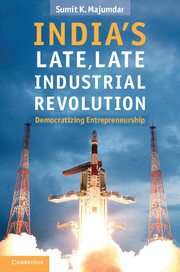Book contents
- Frontmatter
- Contents
- Figures
- Tables
- Acknowledgments
- Preface
- 1 Vent for growth
- 2 Industrial revolutions
- 3 Aspects of Indian enterprise history
- 4 The emergence of modern industry
- 5 Asian late industrialization
- 6 Democratizing entrepreneurship
- 7 Contemporary India
- 8 The services sector debate
- 9 A paean for manufacturing
- 10 Reindustrializing India
- Appendix
- Notes
- Bibliography
- Index
8 - The services sector debate
Published online by Cambridge University Press: 05 June 2012
- Frontmatter
- Contents
- Figures
- Tables
- Acknowledgments
- Preface
- 1 Vent for growth
- 2 Industrial revolutions
- 3 Aspects of Indian enterprise history
- 4 The emergence of modern industry
- 5 Asian late industrialization
- 6 Democratizing entrepreneurship
- 7 Contemporary India
- 8 The services sector debate
- 9 A paean for manufacturing
- 10 Reindustrializing India
- Appendix
- Notes
- Bibliography
- Index
Summary
The services sector role in India
The previous chapters have dealt with contemporary Indian entrepreneurship and industrial development. A macroeconomic approach helps in understanding the structure of India’s economy. I ask two questions. Which sectors produce India’s output and income, and in what proportions? And from which sectors has India’s gross domestic product growth come from? There are three main sectors of the economy: agriculture, industry, and services. Their activities comprise the national income statistics. The discussion revolves around the relative performance of these three sectors. When we talk about manufacturing industries and service industries, the term “industry,” in national accounts statistics, refers to the actual manufacturing, mining, electricity, gas, and water sectors. The term “services” refers to construction, trade, hotel, transport, communications, finance, insurance, real estate, professional business services, community services, social services, and personal services.
Is India’s growth story a service sector growth story? The manufacturing sector in India has performed well and, relatively, brilliantly in relation to its past performance. Yet India’s growth has been unleashed by her service sector businessmen. This phenomenon is considered consequential. In the last six decades, agriculture, which was the sector providing the key economic sustenance to India’s millions, has shrunk. Its share of national income was almost 54 percent in the 1950s, during the decade as a whole. It had shrunk to 20 percent by the first decade of the new millennium. Which other sectors have absorbed the slack generated?
- Type
- Chapter
- Information
- India's Late, Late Industrial RevolutionDemocratizing Entrepreneurship, pp. 217 - 238Publisher: Cambridge University PressPrint publication year: 2012



